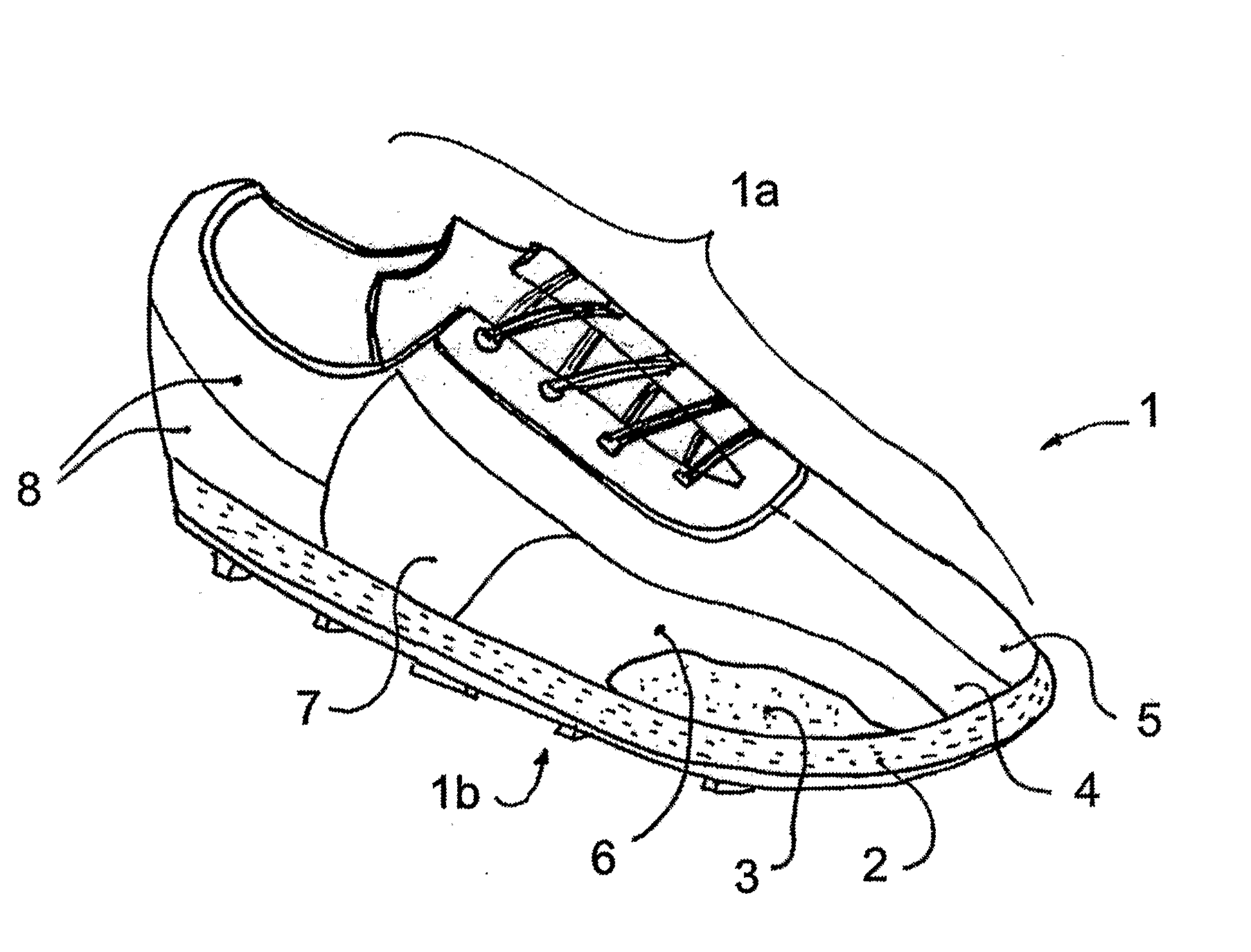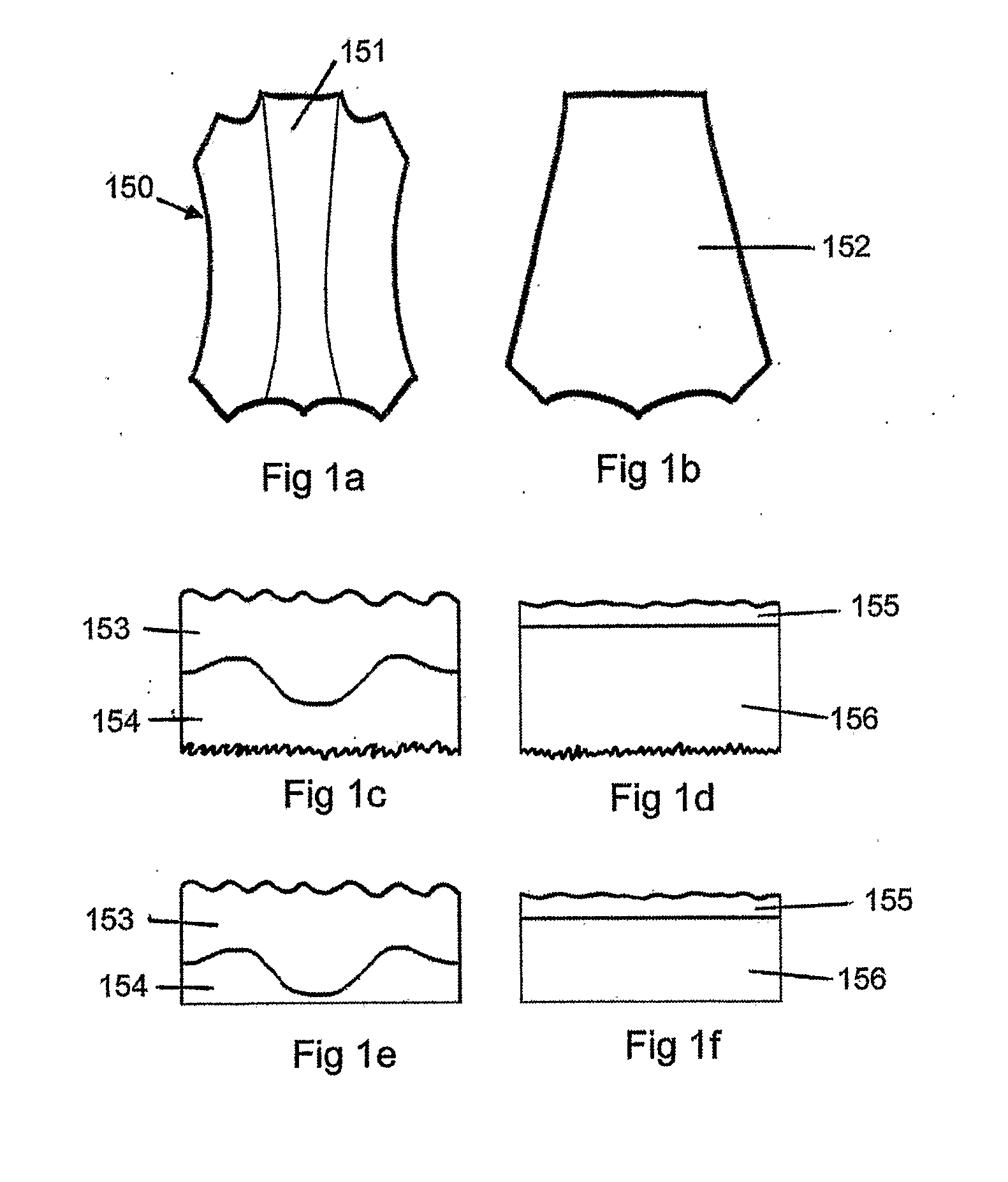Goat Skin for Shoe and Apparel Manufacture
a technology for goat skin and shoe and apparel, applied in the field of goat skin for shoe and apparel manufacture, can solve the problems of not showing the highest abrasion resistance, significant market resistance to sports shoes made of synthetic materials, and relative hard wearing, and achieve the effects of increasing the tearing and/or tensile strength of the leather itself, increasing the adhesion, and strengthening the fibre structure of the leather
- Summary
- Abstract
- Description
- Claims
- Application Information
AI Technical Summary
Benefits of technology
Problems solved by technology
Method used
Image
Examples
example 1
[0144]FIG. 2a illustrates a caprine leather with the grain face (101) and corium (102) layer visible. Ideally this is a shaved leather to about 1.0 mm thickness (other than back bone region) and tanned in a process including excess fat-liquoring and treated to include an acrylic lubricating polymer such as Lubritans by Rohm & Haas (USA).
[0145]The leather has been rotary ironed to reduce the natural grain size, and optionally embossed with a finer grain print.
[0146]To the rear has been applied a bonded resin layer (103) which is a urethane resin exhibiting a reasonable tensile strength. In this embodiment the resin types have a high tensile strength type of at least 6500 psi at break. This is then married with an elongation at break between 400 and 500%. A suitable material is Witcobond W281 Aqueous Polyurethane dispersion from Crompton Europe Ltd.
[0147]This is roller coated on to the non-grain face at a loading of 15-25 g / sqft (though 10-100 g / sqft can be considered depending on the...
example 2
[0149]FIG. 2b illustrates an alternative embodiment of the present invention. For the sake of simplicity we shall use as a basis (for this embodiment) the embodiment of FIG. 2a, with (111) representing the grain layer of the caprine leather, (112) the corium layer, (113) the bonded resin layer, and (114) the protective top coat. Where this embodiment differs is in the incorporation of a reinforcing material (115) into the resin layer (113). This is a woven fabric, laid over the non-grain face of the leather prior to roller-coating the resin. The fabric may be a woven fabric of synthetic fibres (with optional natural fibre content). The synthetic fibres may include: nylon, Kevlar®, Cordura®, Zylon®, Magellan M5®, ballistic fibres, and combinations thereof.
[0150]A different adhesive / resin may be substituted. This may comprise, for example, in parts by weight to a total of 100%:
75-85%an aqueous urethane resin such as a Unires ® resin by Stahlof Europe; 9-15%an aqueous acrylic resin suc...
example 3
[0152]FIG. 2c illustrates a further embodiment of the present invention. For the sake of simplicity we shall use as a basis (for this embodiment) the embodiment of FIG. 2a, with (121) representing the grain layer of the caprine leather, (122) the corium layer, (123) the bonded resin layer, and (124) as an optional protective top coat.
[0153]Where this embodiment differs is in the bonding of a discrete layer (126) to the corium layer (123). This may be bonded by a suitable compatible adhesive, or by the resin layer (123). This layer (126) is typically a woven fabric, preferably impregnated with a polyurethane or other resin layer. The fabric may be a woven fabric of synthetic fibres (with optional natural fibre content). The synthetic fibres may include: nylon, Kevlar®, Cordura®, Zylon®, Magellan M5®, ballistic fibres, and combinations thereof.
[0154]As an option, additional reinforcing material (125) may be positioned within the adhesive / resin layer (123) allowing composite type mater...
PUM
| Property | Measurement | Unit |
|---|---|---|
| thicknesses | aaaaa | aaaaa |
| angle | aaaaa | aaaaa |
| angle of weave | aaaaa | aaaaa |
Abstract
Description
Claims
Application Information
 Login to View More
Login to View More - R&D
- Intellectual Property
- Life Sciences
- Materials
- Tech Scout
- Unparalleled Data Quality
- Higher Quality Content
- 60% Fewer Hallucinations
Browse by: Latest US Patents, China's latest patents, Technical Efficacy Thesaurus, Application Domain, Technology Topic, Popular Technical Reports.
© 2025 PatSnap. All rights reserved.Legal|Privacy policy|Modern Slavery Act Transparency Statement|Sitemap|About US| Contact US: help@patsnap.com



